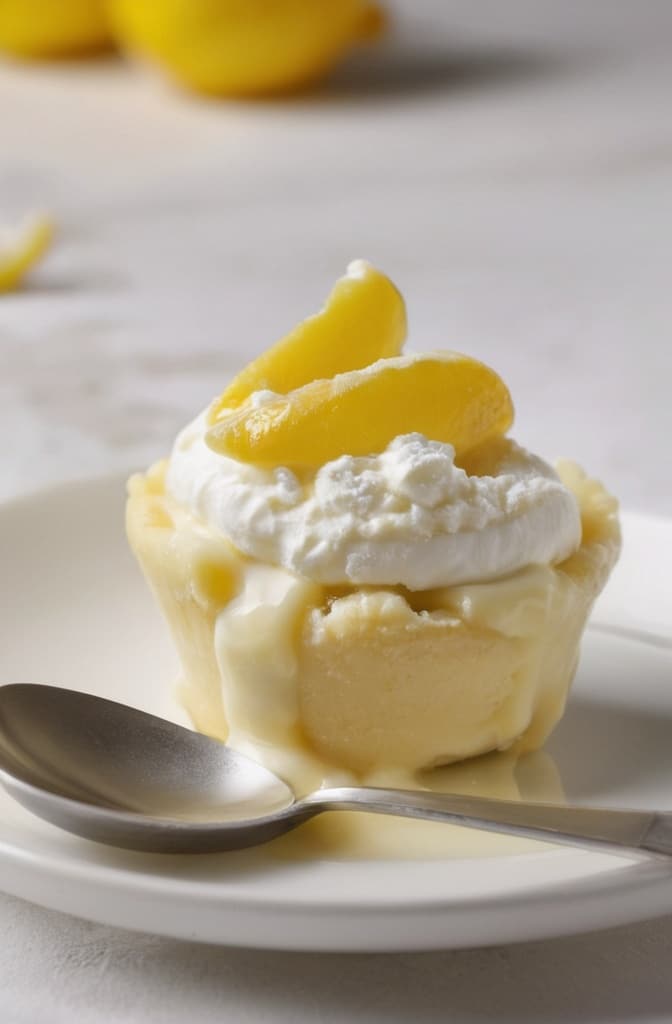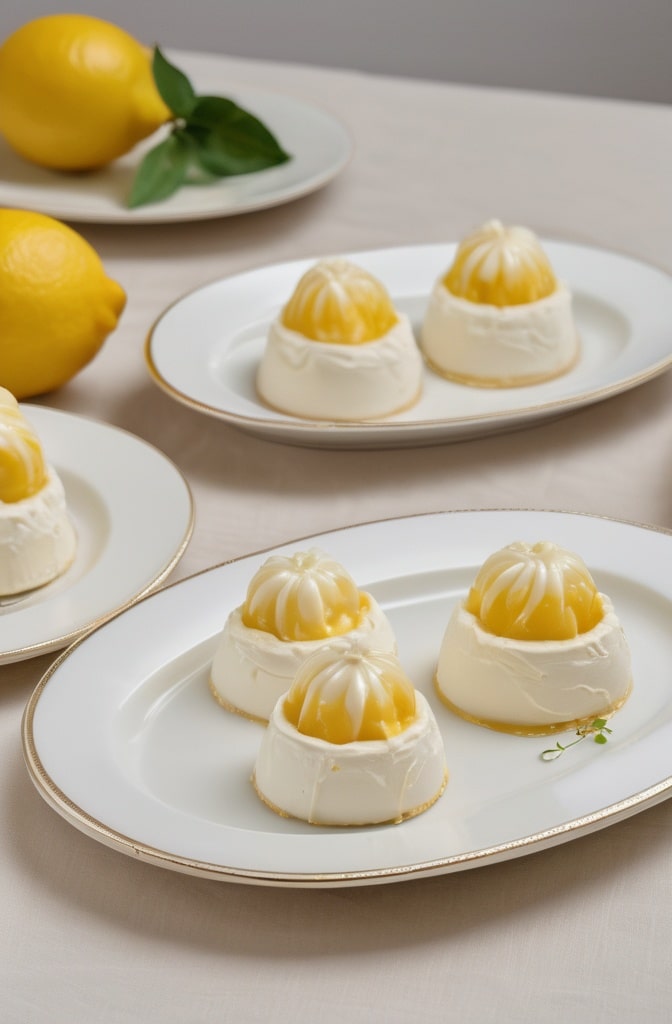The sweet scent of lemon zest mixing with mascarpone always takes me back to my grandmother’s sunlit kitchen in southern Italy. Her hands, slightly wrinkled yet remarkably nimble, would craft these delicate limoncini with effortless precision. I’ve spent years perfecting her technique, and lemme tell you—these aren’t your average Italian cookies. They’re little pockets of sunshine that explode with creamy, citrusy goodness.
These limoncini filled with ricotta delight represent the perfect marriage of tangy citrus and velvety cheese. What sets them apart is the delicate balance between the tender cookie shell and the luscious filling that creates an irresistable textural contrast. These bite-sized treasures showcase the beauty of Italian pasticceria at its finest—simple ingredients transformed through technique into something extraordinary.
Ingredients & Substitutions
For the Limoncini Shells:
- 375g all-purpose flour (tipo 00 flour works beautifully if available)
- 150g cold unsalted butter, cubed
- 120g granulated sugar
- 2 large eggs
- Zest of 3 unwaxed lemons (organic prefered)
- 2 tablespoons fresh lemon juice
- 1 teaspoon pure vanilla extract
- ½ teaspoon baking powder
- ¼ teaspoon fine sea salt
For those with gluten sensitivities, a high-quality cup-for-cup gluten-free flour blend with xanthan gum works surprisingly well, though the texture becomes slightly more crumbly. The butter should be European-style with higher fat content if possibel—it creates a more tender, flavorful cookie. Brown sugar can replace white for a deeper molasses note, but it’ll slightly darken the dough and alter that bright yellow aesthetic.
For the Ricotta Filling:
- 250g fresh whole-milk ricotta, drained overnight
- 125g mascarpone cheese, room temperature
- 100g confectioners’ sugar, sifted
- Zest of 2 unwaxed lemons
- 2 tablespoons limoncello (optional but recomended)
- 1 teaspoon pure vanilla extract
- Pinch of fine sea salt
Always drain your ricotta properly—excess moisture is the enemy of a stable filling. If mascarpone is unavailable, cream cheese with a tablespoon of heavy cream works as a decent substitute. For a dairy-free version, cashew cream cheese blended with coconut cream can approximate the richness, though the flavor profile shifts subtly Mediterranean.
For Finishing:
- 1 egg white, lightly beaten (for sealing)
- Confectioners’ sugar for dusting
- Candied lemon peel for garnish (optional)
- Fresh mint leaves (optional)
Step-by-Step Instructions

Preparing the Limoncini Dough:
- In a large mixing bowl, combine flour, sugar, baking powder, and salt. Whisk briefly to distribute the dry ingredients evenly. The proper incorporaton of these ingredients establishes the structural foundation of your cookies.
- Add the cold butter cubes and work them into the flour mixture using a pastry cutter or your fingertips until the mixture resembles coarse breadcrumbs. Some chefs use a food processor for this step, but I find manual mixing gives superior control over the texture—you want pea-sized butter pieces remaining for flakiness.
- In a separate bowl, whisk together eggs, lemon zest, lemon juice, and vanilla extract. Pour this wet mixture into the flour-butter mixture and gently fold with a wooden spoon until just combined. Be carefull not to overmix; stop when no dry flour remains visible but the dough still looks somewhat shaggy.
- Turn the dough onto a lightly floured surface and knead gently 3-4 times until it comes together. Shape into a disc, wrap in reusable food wrap, and refrigerate for at least 1 hour, though 2 hours yields optimal results. This resting period allows the gluten to relax and the butter to firm up, ensuring your cookies maintain their shape during baking.
Creating the Ricotta Filling:
- While the dough chills, place the drained ricotta in a large bowl and beat with an electric mixer on medium speed until smooth, about 1 minute. Many home cooks skip this step, but breaking down the ricotta molecules creates a silkier mouthfeel in the final product.
- Add the mascarpone and beat until fully incorporated and fluffy, approximately 2 minutes. The mixture should appear lightened in both color and texture. Scrape down the sides of the bowl freqently to ensure even mixing.
- Gradually add the sifted confectioners’ sugar while mixing on low speed to avoid a sugary dust cloud (I’ve learned this the hard way more than once!). Once incorporated, add lemon zest, limoncello, vanilla extract, and salt, then increase to medium speed and beat until the filling is smooth and holds soft peaks, about 3 minutes.
- Transfer the filling to a piping bag fitted with a medium round tip (or simply cut the corner off a zip-top bag if you dont have piping equipment). Refrigerate for at least 30 minutes to firm up before assembling the cookies.
Assembling and Baking:
- Preheat your oven to 350°F (175°C) and line two baking sheets with parchment paper or silicone mats. Remove the chilled dough from the refrigerator and let it sit at room temperature for 5-10 minutes to facilitate rolling.
- On a lightly floured surface, roll the dough to approximately 3mm thickness (about ⅛ inch). Using a 7cm (2¾ inch) round cookie cutter, cut out as many circles as possible. Re-roll scraps as needed, but limit this to once or twice to avoid tough cookies.
- Place about 1 teaspoon of the ricotta filling in the center of half the dough circles. Be careful not to overfill—a common mistake that leads to filling escaping during baking. Leave a 1cm border around the edge.
- Brush the borders lightly with beaten egg white, then top with remaining dough circles. Press the edges gently with a fork to seal, being careful not to tear the dough. The tines of the fork create not only a secure seal but also that classically recognizable decorative edge that signals a hand-crafted touch.
- Transfer the assembled cookies to the prepared baking sheets, spacing them about 4cm (1½ inches) apart. Pierce the top of each cookie once with a fork to allow steam to escape during baking.
- Bake in the preheated oven for 12-15 minutes, rotating the pans halfway through, until the edges are just barely golden. It’s better to slightly underbake than overbake these delicate treats—they’ll firm up as they cool.
- Allow the limoncini to cool on the baking sheets for 5 minutes before transferring to a wire rack to cool completely. Dust generously with confectioners’ sugar just before serving, and garnish with candied lemon peel and mint leaves if desired.
Cooking Techniques & Science
The success of these limoncini hinges on a few critical technical elements that are worth understanding. The cold butter incorporated into the flour creates little pockets of fat that, when heated, release steam and create a tender, flaky texture. This is why keeping the dough cold throughout the process is so crucial—warm butter will integrate too fully into the flour, resulting in a tougher cookie.
When working with citrus zest, its essential to only take the colorful outer layer and avoid the bitter white pith. The colorful portion contains the essential oils where all the aromatic compounds live. Rubbing the zest into the sugar before mixing (a technique called “zesting sugar”) releases these oils more effectively, infusing the entire dough with vibrant lemon flavor.
The overnight draining of ricotta is not merely a suggestion but a technical necessity. Fresh ricotta contains significant whey, which would seep out during baking and create soggy cookies. A cheesecloth-lined strainer set over a bowl in the refrigerator does the job perfectly. Some professional pastry chefs even press the ricotta gently with a weighted plate to extract maximum moisture.

The limoncello in the filling serves dual purposes: flavor enhancement and preservation. The alcohol content helps stabilize the filling and extends shelf life slightly, while the concentrated lemon flavor amplifies the natural citrus notes. For those avoiding alcohol, a combination of lemon extract and simple syrup can approximate this effect.
The technique of forking the edges serves more than decorative purposes—it creates a proper seal that prevents the filling from leaking while allowing enough structural integrity for the cookies to rise properly. A dull fork works better than a sharp one, as it presses without cutting through the dough.
Serving & Pairing Suggestions
Limoncini reach their peak flavor potential when served slightly chilled but not cold—about 30 minutes out of refrigeration. This temperature allows the ricotta filling to maintain its structure while letting the lemon notes bloom on the palate.
For an elegant presentation, arrange these bright yellow gems on a bed of fresh lemon leaves on a white porcelain platter. The visual contrast creates an appealing display that honors their Mediterranean origins. A light dusting of confectioners’ sugar applied just before serving prevents the disappointment of sugar dissolving into the cookies.
These cookies pair magnificently with an afternoon espresso or a glass of Prosecco for a more celebratory occasion. The bubbles in the Prosecco cut through the richness of the filling while complementing the citrus notes. For a non-alcoholic pairing, a bergamot-infused tea creates a citrus symphony that enhances the lemon without overwhelming it.
Limoncini also make an exquisite component in a dessert tray alongside amaretti and cantucci. Try serving them as the sweet conclusion to a meal of seafood risotto or lemon-herb roasted chicken, where they echo the citrus notes from the main course.
For a truly indulgent experience, sandwich a small scoop of lemon sorbet between two limoncini to create an elevated ice cream sandwich. The contrast between the cold sorbet and the tender cookie creates a textural masterpiece that’s both refined and playful.
Conclusion
Mastering these ricotta-filled limoncini requires attention to detail, but the rewards are immense. The secret to their success lies in respecting the ingredients—quality lemons, fresh ricotta, and good butter make all the difference. Don’t rush the process; the resting times for both dough and filling are essential for developing proper texture and flavor integration.
These cookies represent the essence of Italian dessert philosophy: simple ingredients transformed through technique into something greater than the sum of their parts. While they certainly require some effort, the combination of the tender lemony shell with the creamy, rich filling creates a sensory experience worth every minute spent in preparation.
Remember that practice makes perfect with these delicate treats. Your first batch might not look Instagram-worthy, but they’ll still taste divine. And isn’t that what cooking is truly about? Creating something delicious that brings joy to those who gather around your table.
FAQs About Limoncini Filled With Ricotta Delight Recipe
Can I make the dough and filling ahead of time?
Absolutely! Both components can be prepared up to 48 hours in advance. The dough should be kept wrapped tightly in the refrigerator but will need about 15-20 minutes to soften slightly before rolling. The filling actually improves with an overnight rest as the flavors meld together more harmoniously.
Why did my filling leak out during baking?
There are typically two culprits: overfilling or inadequate sealing. Use no more than a teaspoon of filling per cookie and ensure you’re leaving a proper border around the edge. Press firmly (but gently) with a fork to create a true seal, and don’t skip the egg white wash—it acts as the glue that holds everything together.
Can I freeze these cookies?
Yes, but with some caveats. They freeze best before baking—assemble them completely, place on a baking sheet until frozen solid, then transfer to an airtight container. Bake directly from frozen, adding 2-3 minutes to the baking time. Already-baked limoncini can be frozen, but the texture of the filling may become slightly grainy upon thawing.
How long do these cookies stay fresh?
When stored in an airtight container in the refrigerator, limoncini will maintain optimal quality for about 3-4 days. The cookies soften slightly over time as they absorb moisture from the filling, creating an almost cake-like texture that many find equally delightful, just different from the fresh version.
Can I make a version with less sugar?
You can reduce the sugar in the filling by up to 25% without significantly impacting the structure. However, I wouldn’t recommend further reduction as sugar contributes not only sweetness but also to the texture and preservation of the filling. For the cookie dough, reducing sugar will result in a less tender cookie, so proceed with caution.

